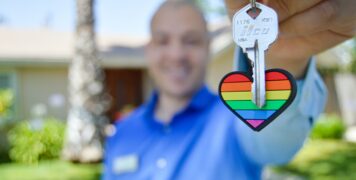Contact
020 4515 6728
info@ccameron.co.uk
Charles Cameron & Associates
Blackfriars Foundry
154-156 Blackfriars Road
London SE1 8EN
Leasehold, freehold, share of freehold
July 6, 2022
Information published was correct at the time of writing
Key differences between the properties you can purchase

IN ENGLAND AND WALES, there are two types of property: freehold and leasehold. It’s important you know which yours is when you purchase it. There are differences in Northern Ireland and Scotland, so be sure to do your research for those locations. It’s important to understand the key differences between the properties you can purchase.
Leasehold and freehold are two different ways of owning property. If you buy a leasehold property you are entering a legal agreement where you own the property but not the land that it is built on. You will enter a lease agreement with the freeholder of the land. If you’re buying a freehold property you are purchasing the legal rights to the property and the land that it is built on. Your name will be listed on the land registry as the ‘freeholder’.
MAIN DIFFERENCES BETWEEN THEM:
Freehold: Essentially, freehold is the complete free rights to the ownership of a property. Aside from planning permission, if you own a home under freehold you are entitled to do what you want with it.
• There is no annual ground rent to pay.
• Sole responsibility for the maintenance of the building and managing the land rests with you, the freeholder.
• There are no limitations on what you can do in your home, for example, you are free to own pets, smoke or carry out building work (with planning permission).
• There is no fear of declining value purely related to the term of a lease running out, or the need to pay for an expensive renewal of the lease.
• Freehold is the most normal way of selling houses as they are standalone properties and include the land they sit on.
Leasehold: Leasehold means that you just have a lease from the freeholder (sometimes called the landlord) to use the home for a number of years. The leases are usually long term – often 90 years or 120 years and as high as 999 years – but can be short, such as 40 years.
• A leaseholder buys a lease for a property from the freeholder.
• The contract between the leaseholder and freeholder details the legal responsibilities and rights of each party.
• The freeholder is usually responsible for the upkeep of the common areas of the building, as well as the roof and exterior walls.
• As well as the initial purchase price of the leasehold property, the leaseholder will need to pay annual ground rent, annual service charges, maintenance fees and a share of insurance for the buildings.
• Leaseholders cannot usually undertake any major works on the property without the permission of the freeholder.
• Leaseholders may be subject to other restrictions on how they use their property, such as subletting rooms or pet ownership.
• The lease can become forfeit if a leaseholder does not fulfil their side of the contract.
• Leaseholders can claim the ‘Right to Manage’, which means they can legally take over management of the property from the freeholder.
SHARED FREEHOLDS
A similar system to commonhold, shared freeholds involve all leaseholders jointly owning the freehold. Each owner of a leasehold property within the development or complex owns a share of the freehold, and management of the building as a whole is shared by all the leaseholders.
Don’t forget, our professional, friendly advisers are on hand to support you and can help you explore all of your options.



